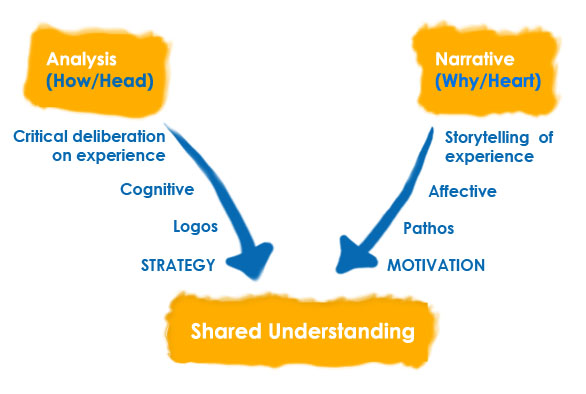
Veteran organizer Marshall Ganz is is credited with devising the successful grassroots organizing model and training for Barack Obama’s winning 2008 presidential campaign. (AP Photo/Stephan Savoia)
Why tell stories?
Storytelling is one of the most powerful tools organizers can use to unite a movement. Your story is the “why” of organizing — the art of translating values into action through stories. It is an ongoing discussion process through which individuals, communities and nations construct their identity, make choices and inspire action. Each of us has a compelling story to tell that can move others.
Two ways to engage
Leaders employ both the “head” and the “heart” in order to mobilize others to act effectively on behalf of shared values. In other words, they engage people in interpreting why they should change their world — their motivation — and how they can act to change it — their strategy.
Many leaders are good at the analysis side of public speaking: They focus on presenting a good argument or strategy. Alternatively, other leaders tell their personal story, often a tale of heartbreak that educates us about the challenge but doesn’t highlight the potential for successfully realizing the end goal.
An effective story of self has to have elements of both the analytical and the emotional. It is a story that involves the head and the heart — and moves people to use their hands and feet in action.
Action is inhibited by inertia, fear, self-doubt, isolation and apathy. Action is facilitated by urgency, hope, knowing you can make a difference, solidarity and anger. Stories mobilize emotions that urge us to take action and help us overcome emotions that inhibit us from action.
The key to storytelling is understanding that values inspire action through emotion. We experience our values emotionally — they are what actually move us to act. Because stories allow us to express our values not as abstract principles, but as lived experience, they have the power to move others to action as well.
Finding your story of self’s “choice point”
A story of self tells why we have been called to serve. It expresses the values or experiences that call each person to take leadership on a given issue.
The key focus is on choice points: moments in our lives when values are formed because of a need to choose in the face of great uncertainty. When did you first care about being heard, or learn that you were concerned about the issue on which you want to take action? Why? When did you feel you had to do something about it? Why did you feel you could? What were the circumstances? What specific choice did you make?
The three key elements of storytelling structure:
Challenge — Choice — Outcome
A plot begins with an unexpected challenge that confronts a character with an urgent need to pay attention, to make a choice — a choice for which he or she is unprepared. The choice yields an outcome, and the outcome teaches a moral.
Because we can empathetically identify with the character, we can “feel” the moral. We not only hear about someone’s courage; we can also be inspired by it.
The story of the character and their effort to engage around values engages the listener in their own challenge, choice and outcome relative to the story. Each story should include all three elements. It’s not enough to say, “I was scared.” You need to say, “I was very scared, I needed to decide, and when I did, I learned it was possible.” Challenge, choice, outcome.
Incorporating challenge, choice and outcome in your own story
There are some key questions you need to answer as you consider the choices you have made and the path you have taken that brought you to this point in time as a leader. Once you identify the specific relevant choice point, dig deeper by answering the following questions.
Challenge: What was the specific challenge you faced? Why did you feel it was a challenge? What was so challenging about it? Why was it your challenge?
Choice: What was the specific choice you made? Why did you make the choice you did? Where did you get the courage (or not)? Where did you get the hope (or not)? How did it feel?
Outcome: What happened as a result of your choice? What hope can it give us? How did the outcome feel? Why did it feel that way? What did it teach you? What do you want to teach us? How do you want us to feel?
A word about challenge: Sometimes people see the word “challenge” and think that they need to describe the misfortunes of their lives. Keep in mind that a struggle might be one of your own choosing — a high mountain you decided to climb as much as a hole you managed to climb out of. Any number of things may have been a challenge to you and be the source of a good story to inspire others.
Tips
If you’re having trouble getting started, here are some factors that may have contributed to your current choice to take leadership on your issue.
Family and childhood: Your parents and family, experiences growing up, the community in which you grew up, your role models, your school
Life choices: Schools you went to, the career you chose, your partner and family, your hobbies, interests and talents, challenges you’ve overcome
Organizer experiences: Role models, your first experience organizing, your first awareness of the issue on which you want to take action
Focus on one key story — one event or one place or one important relationship. Take some time to think about the elements of your story in the context of the challenge, choice and outcome. In this case, the outcome might also be the thing you learned, in addition to what actually happened.
Remember, the purpose of telling your story of self is to begin to create common ground with your audience by sharing a story that reflects the values that brought you to work on your given issue, and where those values come from.
These tips for constructing your “story of self” are adapted from 350.org’s toolkit, which was compiled with help from Marshall Ganz and other organizing experts. This post is published under the Creative Commons license and can be reprinted.



